Introduction
This document describes how to use the Session Initiation Protocol (SIP) Profile Test Tool that is available for use on Cisco.com.
Prerequisites
Requirements
The information in this document is based on ISR platforms running Cisco IOS® and Cisco IOS® XE software.
Components Used
Cisco recommends that you have knowledge of these topics:
- Navigation through Cisco IOS®
- SIP message format and transactions
The information in this document was created from the devices in a specific lab environment. All of the devices used in this document started with a cleared (default) configuration. If your network is live, ensure that you understand the potential impact of any command.
Background Information
SIP Profiles are used in order to manipulate header information in the SIP messages. They can also be used to make changes in the Session Description Protocol (SDP), which is used to negotiate media.
Common SIP Message Normalization Scenarios
This section provides several SIP message normalization scenarios that have been seen frequently. Each scenario includes the configuration required on Cisco IOS for your reference and a screenshot from the SIP Profile Test Tool that is mentioned in the Introduction.
These scenarios can be used as references for other manipulation required on the SIP messages.
Copy Value from Diversion Header to the From Header
voice class sip-profiles 1
request INVITE sip-header Diversion copy "<sip:(.*)@.*" u01
request INVITE sip-header From copy ".*<sip:(.*)@.*" u02
request INVITE sip-header From modify "(.*)<sip:.*@(.*)" "\1<sip:\u01@\2"
request INVITE sip-header From modify "<sip:@" "<sip:\u02@"
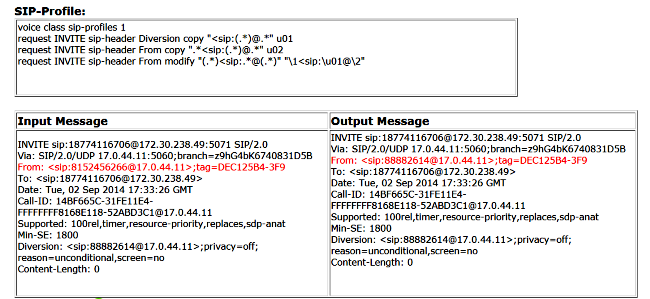
Copy Number from To Header in an Incoming Invite to the REQ-URI Parameter (Prior to Cisco IOS Version 15.4)
Copy the number in the To header in an inbound Invite message and modify the outgoing INVITE:
voice class sip-copylist 1
sip-header TO
voice class sip-profiles 2
request INVITE peer-header sip TO copy "sip:(.*)@" u01
request INVITE sip-header SIP-Req-URI modify ".*@(.*)" "INVITE sip:\u01@\1"
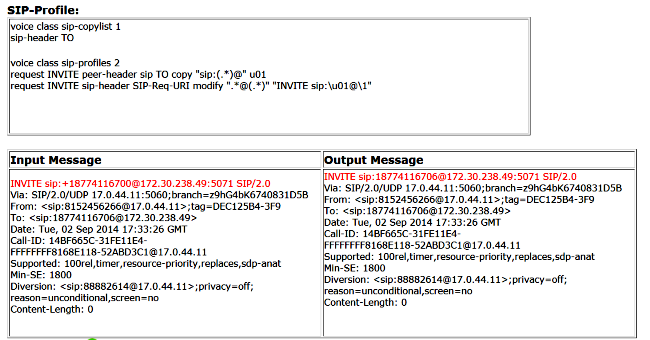
Copy Number from To Header in an Incoming Invite to the REQ-URI Parameter (with Inbound SIP Profiles)
voice class sip-profiles 1
request INVITE sip-header TO copy "sip:(.*)@" u01
request INVITE sip-header SIP-Req-URI modify ".*@(.*)" "INVITE sip:\u01@\1"
voice service voip
sip
sip-profiles inbound
sip-profiles 1 inbound
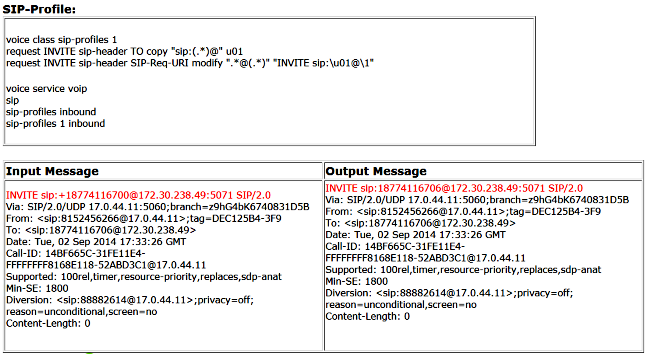
One-way / No-way Audio Interoperability Issues with Provider
voice class sip-profiles 200
request ANY sdp-header Audio-Attribute modify "a=inactive" "a=sendrecv"
request ANY sdp-header Audio-Connection-Info modify "0.0.0.0" "CUBE’s IP"
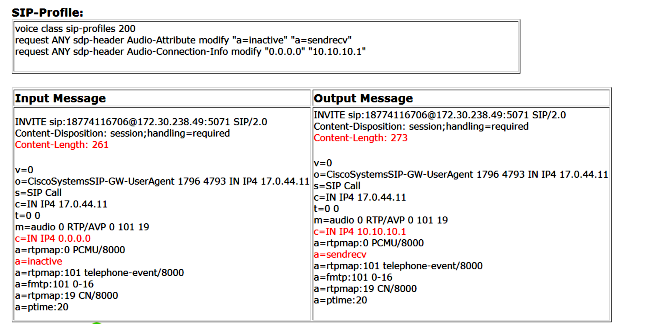
Remove the UPDATE Method Support to Avoid Interoperability Issues
voice class sip-profiles 200
request ANY sip-header Allow-Header modify ", UPDATE" ""
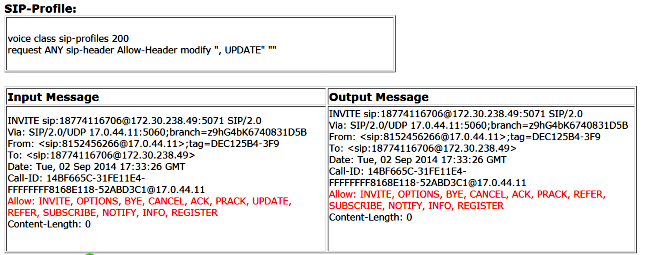
IP Address to Domain Name Conversion
voice class sip-profiles 1
request ANY sip-header SIP-Req-URI modify "10.67.138.241:5060" "sipp.cisco.com"
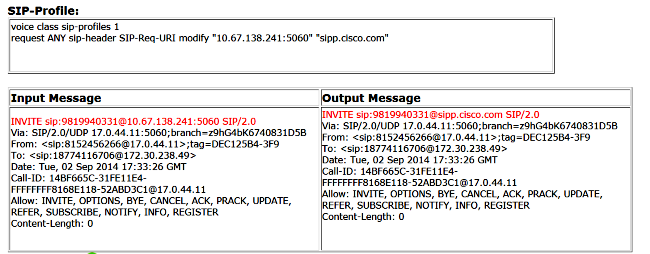
Add a Prefix in the Diversion Header
voice class sip-profiles 1
request ANY sip-header Diversion modify "sip:(.*)@" "sip:704264\1@"
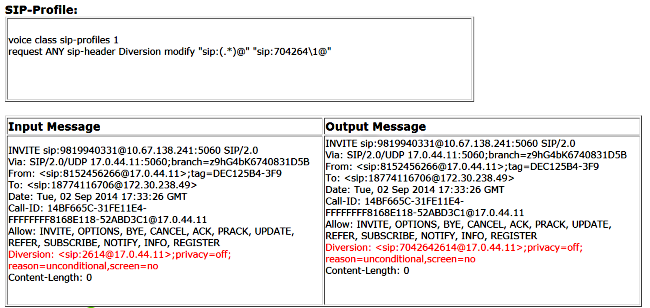
Set DID Number in Diversion Header
voice class sip-profiles 1
request INVITE sip-header Diversion modify "sip:(.*)@" "sip:7042642614@"
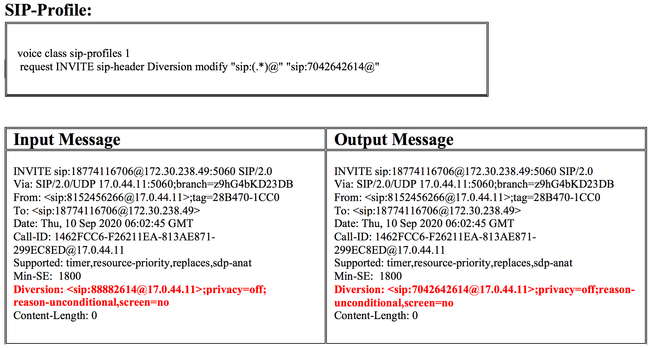
Remove Diversion Header
voice class sip-profiles 1
request INVITE sip-header Diversion remove
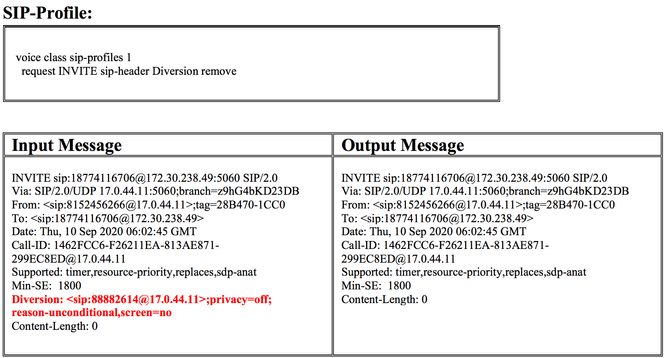
Copy Location Number for Caller ID in Local Gateway (Webex Calling Deployments in United States, Canada, and Puerto Rico)
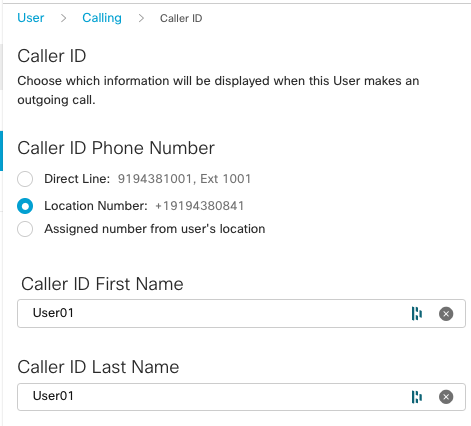
voice service voip
sip
sip-profile inbound
voice class sip-profiles 201
rule 1 request INVITE sip-header From copy "<sip:(.*)@" u01
rule 2 request INVITE sip-header P-Asserted-Identity modify "<sip:.*@(.*)>" "<sip:\u01@\1>"
voice class tenant 200
sip-profiles 201 inbound
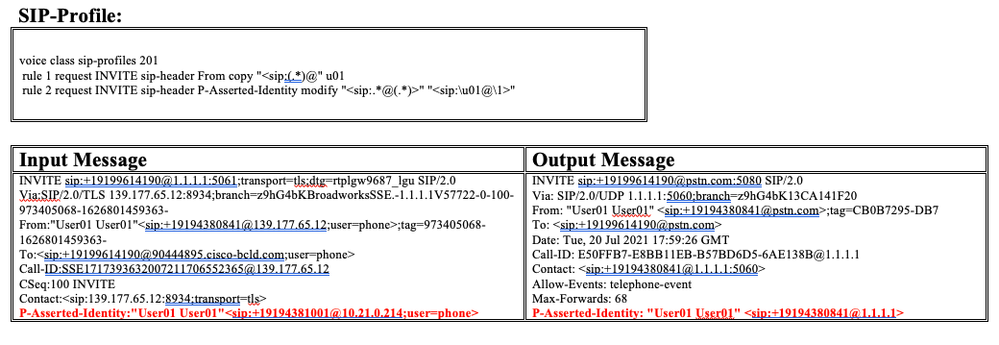
Possible Issues
Here are some possible issues you can encounter.
- After Cisco IOS Version 15.4, the SIP profile feature is introduced to modify inbound SIP messages as well.
- Cisco IOS Versions 15.3 and earlier only support SIP profiles in the outbound direction.
Related Information
In Depth Explanation of Cisco IOS and IOS-XE Call Routing
Understanding Inbound and Outbound Dial Peers Matching on IOS Platforms












 Feedback
Feedback